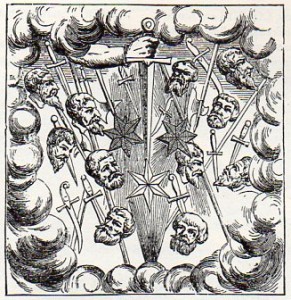No. 4 in our Comet of the Week: The Great Comet of 1528. The best thing about this comet is its description, provided by Monsieur Ambroise Pare, “the father of modern surgery”:
“This comet was so horrible, so frightful, and it produced such great terror in the vulgar, that some died of fear, and others fell sick. It appeared to be of excessive length, and was of the colour of blood. At the summit of it was seen the figure of a bent arm, holding in its hand a great sword, as if about to strike. At the end of the point there were three stars. On both sides of the rays of this comet were seen a great number of axes, knives, blood-coloured swords, among which were a great number of hideous human faces, with beards and bristling hair.”
He even draws it for us:

(from Pare’s “Livres de Chirurgie,” in a chapter titled “Des Monstres Celestes.” Paris, 1597.)
One problem with this comet is that no one else saw it. There’s no other record of the Great Comet of 1528.
Even though he was no astronomer, Pare ought to be a reliable witness. He was court surgeon to Kings Henry II, Francis II, Charles IX, and Henry III. He’s famous for his many innovations in medicine and surgery, not the least of which were the prosthetics he invented for war amputees. Pare devised the first mechanical artificial hand, operated by catches and springs that simulated the joints of a real hand. It looked like this:
But still: ” . . . a great number of axes, knives, blood-coloured swords, among which were a great number of hideous human faces, with beards and bristling hair . . .”
Really, Pare? Really?
